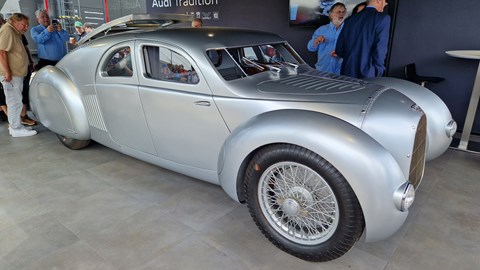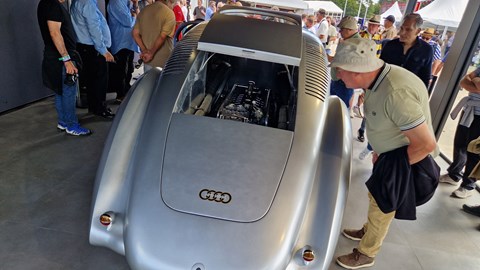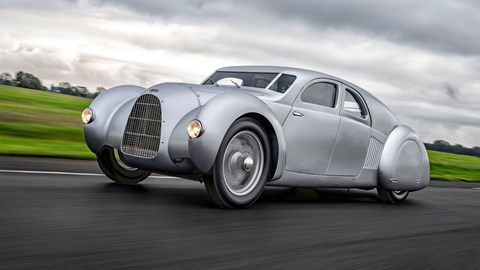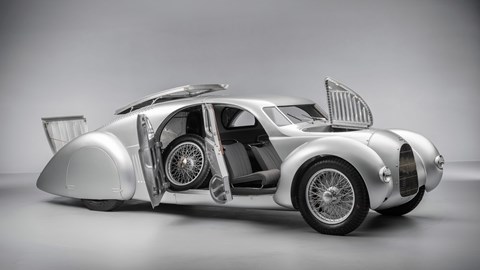► Auto Union Type 52 brought to life at last
► Street-legal 1930s Grand Prix car with 512bhp
► Conceived in period but never built – until now
Given that Audi Tradition unveiled this Auto Union Type 52 Schnellsportwagen at the 2024 Goodwood Festival of Speed last Thursday, you might accuse us of being a little late to the story on the following Monday. But since Audi itself has taken over 90 years to build this thing – or rather, have it built – we figured a few extra days probably wasn’t going to hurt.
Besides, it’s such a bonkers project that it deserves its own space in the electronic sun, slightly removed from the furore surrounding the festival. What you’re looking at here is a brand new example – probably, in fact, the only example – of a car originally conceived back in 1933.
But that’s not the mad bit. The insanity here is that the Type 52 was designed to be a street-legal, road-going version of the 16-cylinder Auto Union Grand Prix cars that smashed all sorts of records and won stacks of trophies during those heady inter-War heydays.
What’s more, the Schnellsportwagen moniker used by the original concept papers and the Avant-ish body-shape (ok, we’re getting carried away) makes it perhaps the great-great-grandfather of every subsequent fast Audi estate; as with the seminal Audi RS2, Porsche was involved, too. And to make matters even more interesting, this modern recreation is even wilder than the original concept.
What on earth is going on here?
Exactly! This is literally the most Goodwood bit of kit we’ve ever seen. It’s seemingly an untold piece of Silver Arrows history – the Silver Arrows being the collective name for the Auto Union and Mercedes-Benz racing cars that drove motorsport development forward in the pre-WW2 period.

According to Audi Tradition, plans for a street-legal Auto Union Grand Prix car were instigated at the end of 1933, just months after the initial Auto Union Type A racing car was first proposed to tackle the incoming 750kg formula that would underpin the 1934-1936 Grand Prix seasons.
Working with the Ferdinand Porsche design office – also responsible for the Type A, which is known as the Type 22 by Porsche – Auto Union started to put ‘more concrete’ plans to build the Schnellsportwagen together in 1934. But then abandoned the whole idea in 1935, at which point the concept disappeared into the respective company archives.

Had it come to fruition at the time, the Type 52 was intended to be a customer car that would allow well-heeled adventurers to participate in long-distance road races such as the Mille Miglia or endurance competitions such as Le Mans. A factory racing effort was also apparently discussed.
What’s particularly bold about it is that it maintains the pioneering mid-engine layout of the Auto Union Grand Prix cars. More than half the length of this working recreation is taken up by the engine compartment. If it had been built at the time, it would surely have been in with a shout of being heralded as the first ever supercar. The contemporary design specs make fascinating reading.
Go on, tell us more about the Schnellsportwagen’s original specs
While it was intended to use a bespoke ladder-frame chassis, the Type 52 was designed around the racing V16 drivetrain from the Auto Union Type 22. Although because the engineers weren’t totally insane (something Audi Tradition has clearly set out to rectify, as you’ll see below), a few choice modifications were to be made to this as well.

For starters, the Roots supercharger was to be re-geared to reduce boost, and the 4.4-litre (4358cc) engine’s compression ratio modified so it could run on regular petrol (instead of the wild petrol-alcohol mixes deployed in competition). This would have given the street-legal version around 197bhp at 3650rpm – not to mention 321lb ft at 2350rpm, which would have been pretty attention grabbing in 1934 when delivered via those skinny rear wheels.
And while that is a reduction from the reputed 295bhp and 391lb ft of the racing version, the engineers reckoned the Schnellsportwagen would still be good for ‘around 200km/h’ flat out. That’s 124mph.
A test car was proposed, but as far as Audi Tradition can make out, none was ever built. That means this modern recreation is likely the only Type 52 ever completed.
How close to the original conception is this new version?
Similar in spirit, certainly, but numerous adjustments have been made along the way – many of which Audi believes would have been inevitable during the development process should an original have made it beyond paper.
The build was handed to British experts Crosthwaite & Gardiner. This highly specialised restoration firm has an extensive history of completing similar projects for other brands, as well as being responsible for curating Audi’s own Silver Arrows collection. Making it ideal to undertake producing the Schnellsportwagen from scratch.

This was done ‘in constant and intensive communication’ with Audi Tradition, especially when it came to resolving what’s described as ‘a range of technicalities’. After all, there were very few period records to refer to.
Auto Union came under the Russian occupied zone at the end of the Second World War, which resulted in almost all of the historic racing cars, files and photographs disappearing. As such there are no ‘verified’ contemporary reports about the intended ‘final configuration’ of the Type 52, if there ever even was one.
Some carefully considered decisions therefore had to made between Audi and Crosthwaite & Gardiner. For instance, the road-going suspension design, which differs from that of the racing cars, as well as the position of all the other major components meant the wheelbase had to be lengthened compared with the original design.

Audi also consciously chose to fit the powertrain from the later Auto Union Type C racing cars of 1936 instead of the intended Type A unit from 1934. This was done, it seems, for ease of future management – the parts are compatible with the Type C models already in the Audi collection.
For the same reason, the engine fitted in the Type 52 here is no longer a detuned road-friendly item, but instead full Grand Prix spec, including the requirement of special methanol fuel!
Which means what for the specification of the 2024 Schnellsportwagen?
That exclamation point is no joke. With the full 6.0-litre (6005cc) Auto Union Type C Grand Prix engine, the Schnellsportwagen pictured here has a completely ludicrous 512bhp. Audi declines to speculate on what the resulting top speed would be, but we hope that someone has a go at it at some point…

That fuel mix is 50 per cent methanol, 40 per cent super-unleaded and 10 per cent toluene. The car is 5390mm long, 1780mm wide and 1660mm tall. It weighs 1450kg – an increase over the original’s proposed 1300kg – and will accommodate three people, with a central seating position for the driver and a passenger on each side.
There are two spare wheels in the back, some room for luggage and lovely trimming in the cabin. But not very much in way of creature comforts; we sincerely doubt that sealed bulkhead does much to reduce the noise from the engine compartment at speed.

There was no record of the intended colour, but given all of the above it seems highly appropriate the Type 52 Schnellsportwagen recreation has been painted the same Cellulose Silver as the racing cars.
What a hoot – just imagine taking one of these on your 1930s commute.